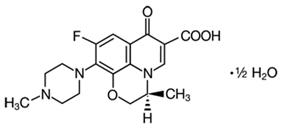11 DESCRIPTION
Levofloxacin is a synthetic broad-spectrum antibacterial agent for intravenous administration. Chemically, levofloxacin, a chiral fluorinated carboxyquinolone, is the pure (-)-(S)-enantiomer of the racemic drug substance ofloxacin. The chemical name is (-)-(S)-9-fluoro-2,3-dihydro-3-methyl-10-(4-methyl-1-piperazinyl)-7-oxo-7H-pyrido[1,2,3-de]-1,4-benzoxazine-6-carboxylic acid hemihydrate.
| Figure 1: The Chemical Structure of Levofloxacin |
 |
The empirical formula is C18H20FN3O4 ∙ ½ H2O and the molecular weight is 370.38. Levofloxacin is a light yellowish-white to yellow-white crystal or crystalline powder. The molecule exists as a zwitterion at the pH conditions in the small intestine.
The data demonstrate that from pH 0.6 to 5.8, the solubility of levofloxacin is essentially constant (approximately 100 mg/mL). Levofloxacin is considered soluble to freely soluble in this pH range, as defined by USP nomenclature. Above pH 5.8, the solubility increases rapidly to its maximum at pH 6.7 (272 mg/mL) and is considered freely soluble in this range. Above pH 6.7, the solubility decreases and reaches a minimum value (about 50 mg/mL) at a pH of approximately 6.9.
Levofloxacin has the potential to form stable coordination compounds with many metal ions. This in vitro chelation potential has the following formation order: Al+3>Cu+2>Zn+2>Mg+2>Ca+2.
Excipients and Description of Dosage Forms
Levofloxacin Injection
The appearance of Levofloxacin Injection may range from a clear yellow to a clear greenish-yellow solution. This does not adversely affect product potency.
Levofloxacin Injection Premix in Single-Use Flexible Containers is a sterile, preservative-free aqueous solution of levofloxacin with pH ranging from 3.8 to 5.8. This is a dilute, non-pyrogenic, nearly isotonic premixed solution that contains levofloxacin in 5% Dextrose (D5W). Solutions of hydrochloric acid and sodium hydroxide may have been added to adjust the pH.
The flexible plastic container is latex-free and fabricated from a specially formulated polyvinylchloride. The amount of water that can permeate from the container into the overwrap is insufficient to affect the solution significantly. Solutions in contact with the flexible container can leach out certain of the container's chemical components in very small amounts within the expiration period. The suitability of the container material has been confirmed by tests in animals according to USP biological tests for plastic containers.